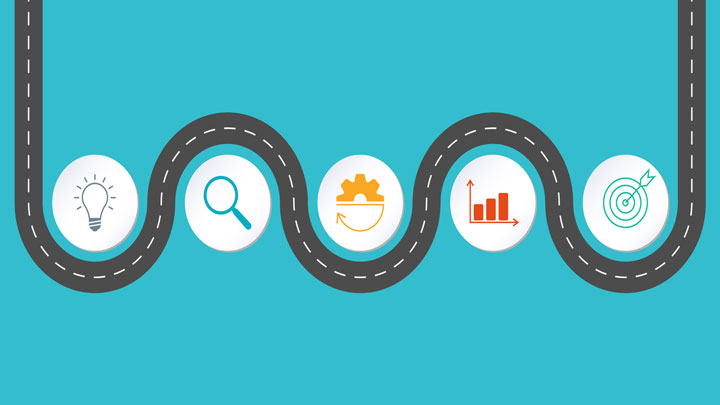Every organization or business needs to set a goal to achieve success, but is it enough to set a goal in the minds of some influential members? Isn’t it necessary that other members of the organization and all people involved in the work understand the goals and the path ahead? Undoubtedly, the goal set by the organization’s founders cannot be achieved without common sense and alignment with others. For this purpose, a tool called a road map is used. But what is the roadmap? A road map is like a clear sign that shows all team members where we are and where we want to go. This article discusses the characteristics of a practical roadmap, its types, and essential points for drawing it.
What is the roadmap?
A road map is a visual map of the goals of the team or organization. Every team has goals in mind before starting work, but sometimes people forget these goals or forget their importance. A roadmap is a simple way to make everyone understand these goals and show them to all team members. Organizations and companies use roadmaps to be able to offer the purposes of the group to everyone.
The road map displays all the goals and strategies in the form of a picture, so it can be considered an effective communication tool for interacting with all the people of the organization or team. The information that a practical roadmap should convey to others are:
- The connection and continuity of different goals and strategies and the position of each in the process of reaching the overall goal of the organization;
- Show the resources needed to achieve each of the plans;
- Estimating the time to reach goals ;
- Communication between different parts of the collection.
What is the importance of a roadmap?

1. Creating coordination and agreement between members
The road map shows all the organization’s members what the goals and plans are. Therefore, it creates a shared understanding between the members.
2. Better communication
The road map provides the possibility of comprehensive interaction and communication between different members of the organization. When most people know their goals and plans, they are more involved in their realization.
3. Better display of programs
Once the road map is in place, everything needed is displayed in one big picture. As a result, people will have a better understanding of them. We humans remember images better than writings and scrolls.
4. Removing various parts of the island activity
Sometimes, without a road map, different parts of the organization lose their communication. They are busy with their work and do not care about the impact of their work on other departments. With a roadmap, managers and members of each department will better understand the impact of their work on others.
What features should the roadmap have?
What the roadmap looks like depends on the type of work you do. However, some things should be considered when drawing any road map.
1. be flexible
Determining strategies may become a complicated and ambiguous task. So, using the most precise and general roadmap would be best.
2. Be collaborative
What is the best way to align others with the roadmap? Involve them in drawing it. Consider stakeholders’ and decision makers’ priorities, concerns, and objections when designing the roadmap. If they are involved initially, they will be more involved in the future.
3. Have visual beauty
The eye-catching design and coloring of different road map parts help the audience understand it better. The map should attract the audience’s attention (for example, shareholders and the board of directors).
4. Show the relationship between different parts
If the roadmap is designed for an organization with other departments, it must show longitudinal and transverse relationships between various departments. For example, if a claim depends on another aspect, this dependence should be established with elements such as directional lines.
5. Include important information in it
Important information such as the date of reaching essential goals (for example, the production of the first product) and other data that may indicate the achievement of a significant achievement should be included in the roadmap.
Types of roadmaps
1. Roadmap without time frame
The most spartan roadmap with no time frame is helpful for organizations and businesses just starting. The lack of a time frame makes this map very flexible. On the other hand, the goals of some organizations keep changing due to the nature of their work. Such a map is also suitable for this category of organizations.
2. Combined roadmap
In this roadmap, estimated time frames are determined. For example, one month is charged instead of setting a specific day to reach the goal. The good thing about this plan is that there is a time frame that pushes the teams to work harder but does not put pressure on them to finish the work on a particular day.
3. A roadmap with a specific deadline
A roadmap based on exact dates is a bit strict, but some organizations with sensitive work take advantage of it. For example, in the Manhattan Project, which led to the construction of the first atomic bomb, a precise deadline was set for the first test of the nuclear bomb. Organizations that must reach their goal in a specific time use this roadmap.
How to draw a road map?

1. Determine your goals
Determining the goal is the first step in drawing the road map. The plan defines the frame of your movement. By finding answers to the following questions, you can determine your goals more clearly:
- What is the direction of my team’s efforts?
- How can I use different resources to achieve a goal?
- Is my goal measurable?
- How can I design and monitor the processes to reach the goals?
- What is my goal timing? Are my goals long-term or short-term?
2. Determine the path to the goal
What methods and solutions are necessary to achieve the goals? What should each department or team do? These are the elements that should be included in the roadmap design.
3. Assess the status of your organization or team
The road map should show the path we are going to take. So, by evaluating the performance of different departments, you will find out which departments are working towards the goal and which are working against it. By assessing the organization, it is possible to redefine the goals and the path to reach them based on the goals. For example, suppose you plan to expand the market of your product. In this case, with a detailed evaluation, you can understand what route you should define in the road map.
Product production roadmap
A product production roadmap is one of the most common roadmaps drawn by-product production managers. By designing the roadmap and showing it to the various departments, the product manager ensures that all departments understand the product to be produced. Suppose we want to make a car. The product manager determines each subsidiary’s roadmap until the final product is ready. This roadmap allows the shareholders and the board to monitor the overall development of the product.
Do you have experience in drawing road maps?
If you have experience designing a road map, share it with us and the audience. If you are a manager of an organization, write to us about how the roadmap has helped you understand your organization’s overall goals.



